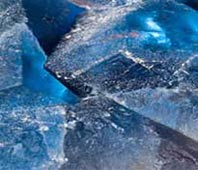
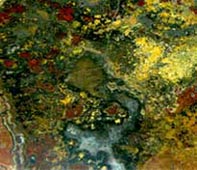
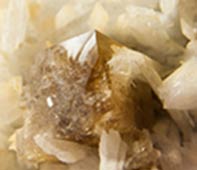
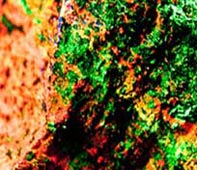
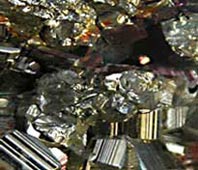
Fluorite and Minerals Associated with the
IL-KY Fluorspar District Fluorite Series — Part II
by Robert Beadle
From: The Pick and Dop Stick, 2/2010
2nd Place — 2011 MWF Original Adult Articles
6th Place — 2011 AFMS Original Adult Articles
In the beginning of this series of articles featuring fluorite, I covered some of the historical background and geology of the Illinois-Kentucky Fluorspar District. I also listed some of the more prominent mines and sub-districts in the region. This part will cover some of the minerals the average collector may encounter. In writing this article I will be using specimens from my own collection along with others as a reference guide to fit the profile of an average collector. One major difficulty lies with the fact that a large part of my southern Illinois minerals list no specific mine for their origin. If I omit some of the rarer minerals from the district, it is because the probability of encountering them is small.
Fluorite (calcium fluoride, CaF2) is the most abundant mineral found in the district, as well as the principal ore being mined. The crystal habit is cubic, sometimes etched by acidic fluids. Interpenetrating twin crystals, reminiscent of some of the English fluorites, are a signature of the ALCOA mine1. Colors range from clear to yellow, purple to black, and light blue to aqua-blue. Green fluorite has been reported from the Rose mine, and pink from the Conn mine. Generally the colors follow the ore horizons, yellow on the Bethel level and purple on the sub-Rosiclare level. Some of the best blue crystals have come from the Denton mine.
Oil (hydrocarbons) frequently coats some of the fluorite crystals. I've seen a moving oil bubble in one of the fluorite crystals. Oil also "includes" in some of the quartz crystals, turning them smoky. The district contained a major oil dome in the Permian Period before the northeast faults formed.
Quartz (silicon dioxide, Si02) crystals are usually small, occurring as druses throughout the district Petroleum- included quartz has been found in rock fractures in the Griffith mine2. Also, I've collected petroleum-included quartz "smoky" on the Columbia mine dump near Marion, KY.
Calcite (calcium carbonate, CaCO3) is, aside from fluorite, possibly the most common mineral in the district. Its colors range from white to honey-brown. Crystal habits of rhombohedral, scalenohedral3, and acicular are found throughout the area. Some of the best calcite crystals have come from the Denton and Annabel Lee mines.
Pyrite (iron disulfide, FeS2) and chalcopyrite (copper iron sulfide, CuFeS2) frequently occur as a coating, or as inclusions in fluorite and other crystals.
Sphalerite (zinc sulfide, ZnS) is widespread throughout the region. I have seen many fluorite crystals associated with sphalerite. Usually the sphalerite serves as the matrix.
Galena (lead sulfide, PbS) is also common throughout the region. The crystals I have seen are elongated cubes, although other habits such as octahedral and cuboctahedral occur in the district.
Barite (barium sulfate, BaSO4) is also widespread and sometimes occurs as druses. But well-formed crystals have been found at Minerva mine No. 1, Denton, Annabel Lee, Gaskins, Crystal, and Victory mines. Barite crystals from these areas can be white, yellow, or blue.
Witherite (barium carbonate, BaCO3) has been found at three mines: Minerva No. 1, West Green, and Ozark- Mahoning No. 7. It is most commonly seen as white or yellow barrel-shaped hexagonal crystals.
Smithsonite (zinc carbonate, ZnCO3) is now rare, having been mined out early in the history of the district. Specimens can still be found, as I have collected smithsonite (turkey-fat ore) on the Old Jim mine dump near Marion, KY. Strontianite (strontium carbonate, SrCO3) is a rare mineral often mistaken for acicular (needle-like) calcite. It can be distinguished from calcite by having gently-curved terminations. Colors range from white to brown and even pink.
Malachite (copper carbonate, Cu2CO3(OH)2) occurs as a weathering product of chalcopyrite. It typically forms crusts upon other minerals. It is my opinion that this is rare, as I've seen only one specimen in many years of collecting.
It has been said that fluorite from the Illinois-Kentucky Fluorspar District doesn't fluoresce very well. For a long time I've taken these authorities at their word. I now present in the following paragraphs the results of my experiments with ultraviolet light upon these minerals from the district.
Petroleum-included quartz (smoky) from the Columbia and Griffith mines fluoresces a bright white under shortwave UV light. Witherite glows white under both long and short wave. It also exhibits phosphorescence after exposure to short wave. Smithsonite from the Old Jim mine fluoresces creamy orange under both wavelengths. Barite from Minerva mine No. 1 glows white under both wavelengths. The underside of one of my specimens (which I believe has petroleum stains) glows yellow. Certain calcites from the district exhibit a faint orange-red fluorescence under short wave.
Some of the fluorites' from the area compare favorably to English fluorite with regards to fluorescence. For example, white fluorite from Mexico, KY and from Hardin Co., IL fluoresces bright blue under long wave. Purple fluorite from the ALCOA mine glows a medium blue under long wave. Grayish light purple fluorite from Minerva mine No. 1 fluoresces a medium blue under long wave. Certain fluorites from the Griffith mine fluoresce bright blue, red, and yellow with red. This is possibly due to dissolved iron in petroleum inclusions in Griffith mine fluorite4. Under short wave, the petroleum shows up as a strong yellow. I have also seen traces of red fluorescence from Minerva mine No. 1 and Denton mine fluorites - always in connection with petroleum inclusions. Fluorites colored dark purple to black normally exhibit no trace of fluorescence.
I hope you enjoyed my article about the many minerals from this region. It was the first major area to contribute significantly to my interest in fluorites. It was also the area that I first started to build my collection out of. In fact, specimens from this area are the foundation of the Beadle collection. My next article will cover fluorites from some interesting mines in England, which is another major specimen producer.
1 Personal communication with Ron Stubblefield, Curator of the Ben E. Clement Museum, in 2001.
2 Personal communication with Garry Griffith, mine operator.
3 Scalenohedral, as in a crystal with faces containing 3 or more pair of congruent scalene triangles (triangles whose three sides and three angles are all unequal)
4 Personal communication with Steve Garzain, Ohio collector
References:
Rocks & Minerals, Vol. 63, No. 3. "Minerals of the Harris Creek Fluorspar District. Hardin Co. Illinois" by Ross C. Lillie, May/June 1988
Mineralogical Record, Vol. 28, No. 1. "The Illinois-Kentucky Fluorite District" by Alan Goldstein, Jan/Feb 1997
The Henry and Patsy Schmidt Collection
The Robert Beadle Collection
For permission to reprint this article, contact us at info@chicagorocks.org.
